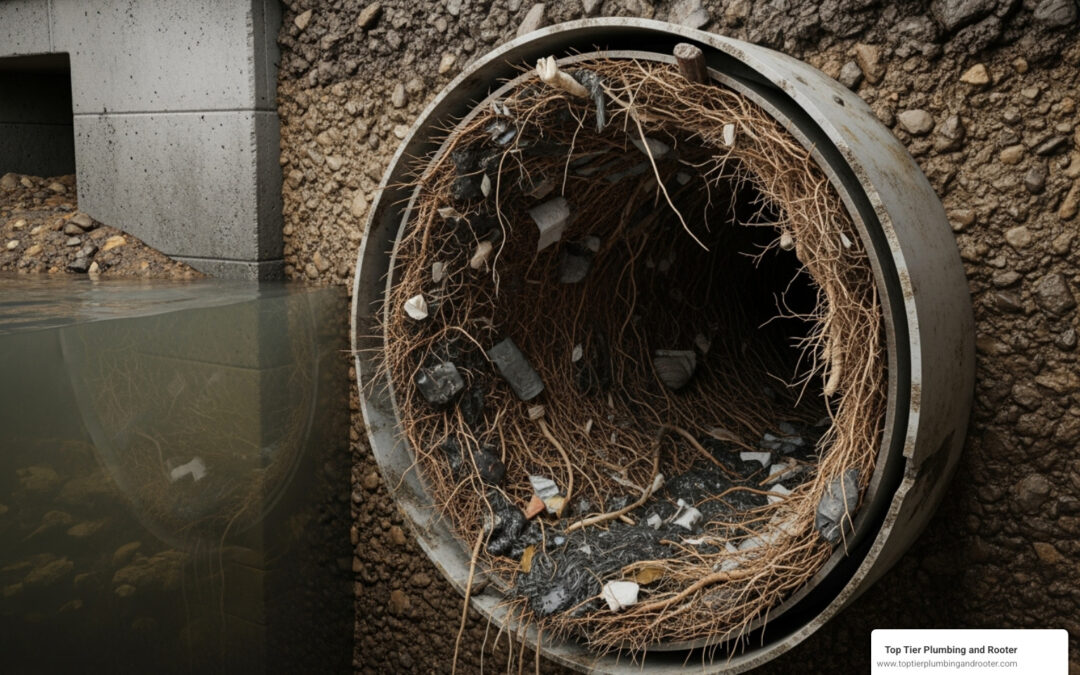When Your Home’s Drainage System Fails: Understanding Main Sewer Line Problems
Sewer line unclog issues can turn your peaceful home into a plumbing nightmare faster than you can say “backup.” When multiple drains start acting up at once, you’re likely dealing with something much bigger than a simple sink clog.
Quick Solutions for Sewer Line Clogs:
- Locate your main sewer cleanout (usually a white or black cap near your home’s foundation)
- Use a plumbing snake/auger to break through the blockage
- Call a professional if multiple fixtures are backing up or you suspect tree roots
- Never ignore the warning signs – they only get worse and more expensive
A main sewer line clog affects your entire home’s plumbing system. Unlike a single drain backup, this problem causes multiple fixtures to drain slowly or back up completely. You might flush the toilet and watch dirty water appear in your shower – a clear sign that wastewater has nowhere to go.
The good news? Many homeowners can tackle basic sewer line clogs with the right tools and knowledge. The research shows that around 80% of people try DIY fixes first, and these methods work about 60% of the time for minor clogs.
But here’s what you need to know upfront: if you’re seeing sewage backup into your home, water pooling in your yard, or multiple drains failing at once, you’re dealing with a serious issue that often requires professional help.
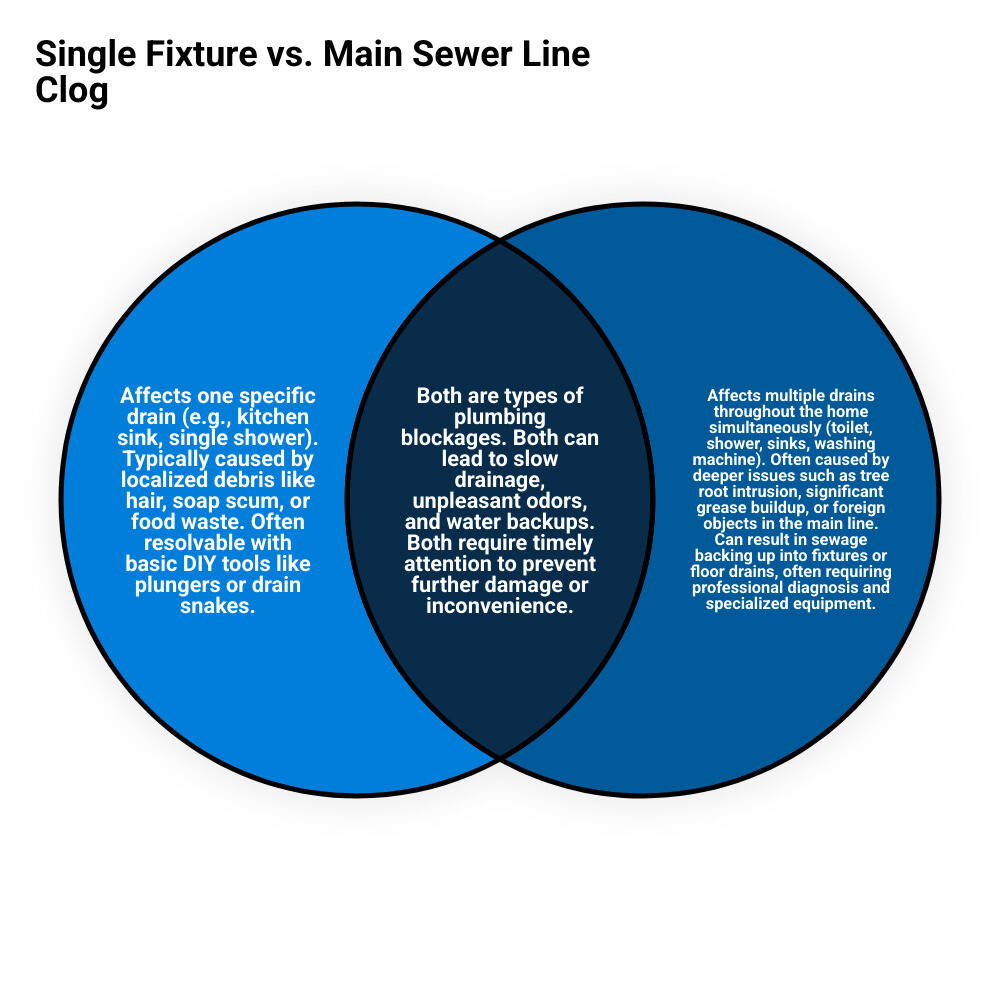
Spotting the Problem: 7 Signs of a Main Sewer Line Clog
Your home’s plumbing system has a way of sending you messages – and trust me, you don’t want to ignore them. When your main sewer line starts backing up, it’s like your house is waving a red flag, begging for attention before things get really messy.
The tricky part? Sewer line unclog problems don’t always announce themselves with a big, dramatic flood. Sometimes they start small, with subtle hints that something’s not quite right in your pipes.
Multiple drains backing up is your biggest clue that you’re dealing with more than just a simple clog. When your toilet, shower, and kitchen sink all decide to act up at the same time, they’re telling you the problem is deeper in your system – literally. It’s like when multiple cars get stuck behind the same roadblock.
You might also notice slow draining fixtures throughout your home. One sluggish drain could just be a localized issue, but when several fixtures are all moving like molasses, that blockage is sitting somewhere in your main line, affecting everything downstream.
Listen carefully to your pipes – they’re trying to talk to you. Those gurgling sounds from pipes aren’t normal plumbing conversation. When your toilet makes weird noises while you’re running the bathroom sink, or your shower drain starts “talking” when you flush, it means air is getting trapped because wastewater can’t flow freely.
Here’s where things get really unpleasant: water backup in unusual places. Picture this – you flush the toilet and dirty water appears in your bathtub. Or you start the washing machine and your toilet overflows. This cross-contamination happens because the wastewater has nowhere to go except back up through the lowest points in your system.
Foul sewage odors drifting up from multiple drains or even in your yard are another dead giveaway. When waste and gases get trapped in your system, they have to go somewhere – and unfortunately, that somewhere might be your living space.
If you have a basement, keep an eye on any floor drains. Wastewater in floor drains often signals a main line problem, especially when it happens every time you use other fixtures upstairs.
Finally, step outside and take a look at your yard. Soggy or flooded areas near where your sewer line runs underground could mean you’ve got a break or severe blockage. This isn’t just inconvenient – it’s a health hazard that needs immediate attention.
The bottom line? These warning signs only get worse when ignored. What starts as a slow drain can quickly turn into a sewage backup that damages your home and puts your family’s health at risk. For more details on what can happen when drainage issues go unaddressed, check out our article on The Hidden Dangers of Ignoring Drainage Issues: What Homeowners Need to Know.
What Causes a Main Sewer Line Backup?
Understanding what’s behind your sewer line unclog problems can save you time, money, and a lot of frustration. Sometimes it’s something you flushed last week, and other times it’s a problem that’s been brewing underground for years.
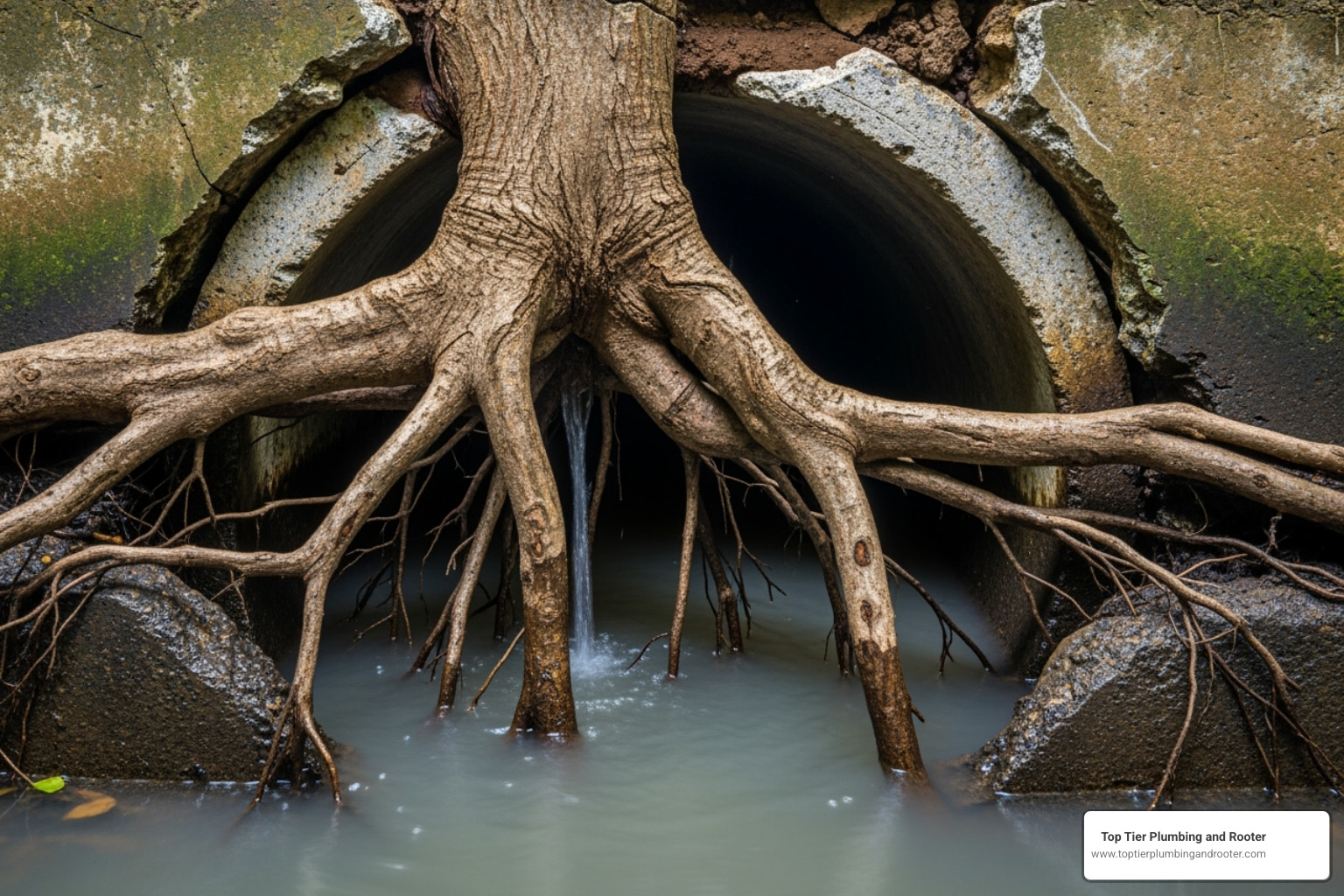
Grease and fat buildup is one of the sneakiest culprits we encounter. That bacon grease you poured down the drain last month? It didn’t just disappear. When hot cooking oils and fats cool down in your pipes, they turn into a sticky coating that acts like flypaper for everything else flowing through your system. Over time, this greasy buildup creates a narrower and narrower passage until water can barely squeeze through.
The foreign objects category might surprise you. We’ve pulled everything from toy cars to jewelry out of sewer lines, but the real troublemakers are items people think are safe to flush. Those so-called “flushable” wipes are particularly notorious – they don’t break down like toilet paper and love to get tangled up with other debris. Feminine hygiene products, cotton swabs, and dental floss are equally problematic.
Tree root intrusion is nature’s way of reminding us who’s really in charge. Tree roots have an amazing ability to find even the tiniest crack in your sewer pipe, drawn by the moisture and nutrients inside. Once they get in, they grow into a dense network that can completely block your line. This is especially common in older neighborhoods with mature trees and aging pipes.
Sagging or broken pipes create their own set of problems. When pipes develop a “belly” due to shifting soil or poor installation, waste and water collect in these low spots instead of flowing freely to the street. Eventually, enough debris accumulates to create a serious blockage. Cracked or broken pipes from ground movement or simple age can cause similar issues.
Don’t overlook scale buildup, particularly if you live in an older home with cast iron pipes. Years of mineral deposits and rust can significantly reduce your pipe’s internal diameter, making it much easier for even small amounts of debris to get stuck and start a clog.
For a deeper dive into these issues, check out our comprehensive guide: Why Do I Have a Clogged Sewer Line?. And if you’re dealing with tree root problems specifically, our article Plumbing Under Siege: Defending Your Pipes from Invasive Roots in Riverside and San Bernardino County has everything you need to know about protecting your pipes from these underground invaders.
A Homeowner’s Guide to a DIY Sewer Line Unclog
When you’re staring at multiple backed-up drains and the reality of a plumber’s bill hits you, it’s natural to wonder: “Can I handle this myself?” The good news is that many homeowners successfully tackle sewer line unclog projects on their own, especially when the blockage isn’t caused by serious pipe damage or massive tree root invasions.
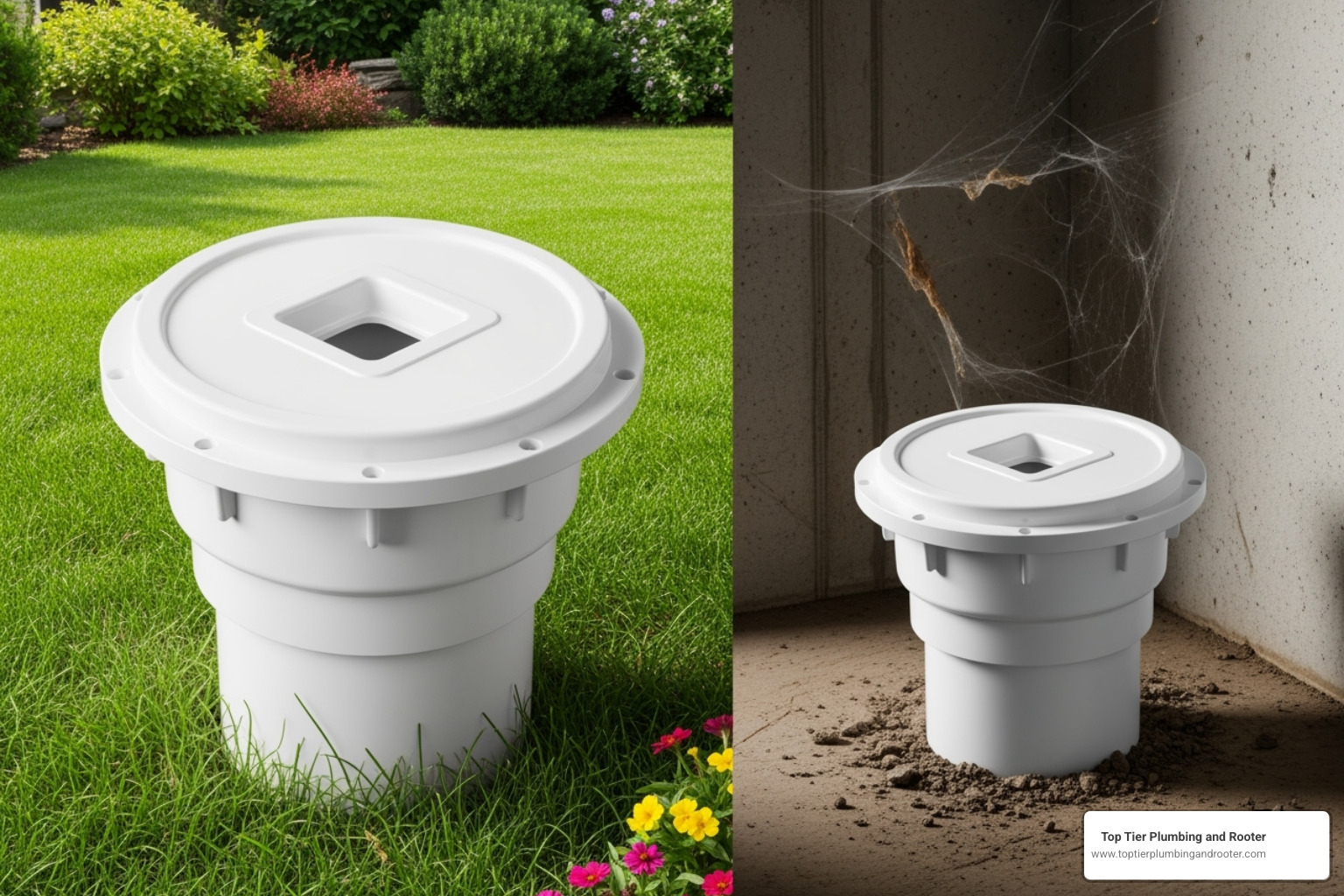
Before we dive into the nitty-gritty details, let’s be honest about what you’re getting into. This isn’t your typical weekend DIY project. You’ll be dealing with raw sewage, which means getting dirty and taking serious safety precautions. But if you’re up for the challenge and the clog isn’t too severe, you could save yourself a significant amount of money.
Safety First: Precautions Before You Begin
Here’s where we need to have a serious conversation about safety. Raw sewage isn’t just unpleasant – it’s genuinely dangerous to your health. Think of it as containing every harmful bacteria and pathogen you’d want to avoid.
Protective gear isn’t optional – it’s absolutely essential. Heavy-duty work gloves and safety glasses are your first line of defense. We also strongly recommend wearing a face mask to avoid breathing in any harmful particles or overwhelming odors that will definitely be present.
Turn off your home’s main water supply if you’re dealing with a severe backup. This prevents more wastewater from entering an already overwhelmed system and potentially creating a bigger mess in your home.
Have your cleanup supplies ready before you start. Prepare for potential backflow by gathering buckets, old towels, and anything else you’ll need to contain the wastewater that will likely spill out when you open the cleanout. Trust us – you don’t want to be scrambling for towels while sewage is flowing onto your basement floor.
Essential Tools for a Sewer Line Unclog
You probably have some of these tools already, but others might require a trip to the hardware store or rental center. Don’t try to skimp on equipment – having the right tools makes the difference between success and a frustrating, messy failure.
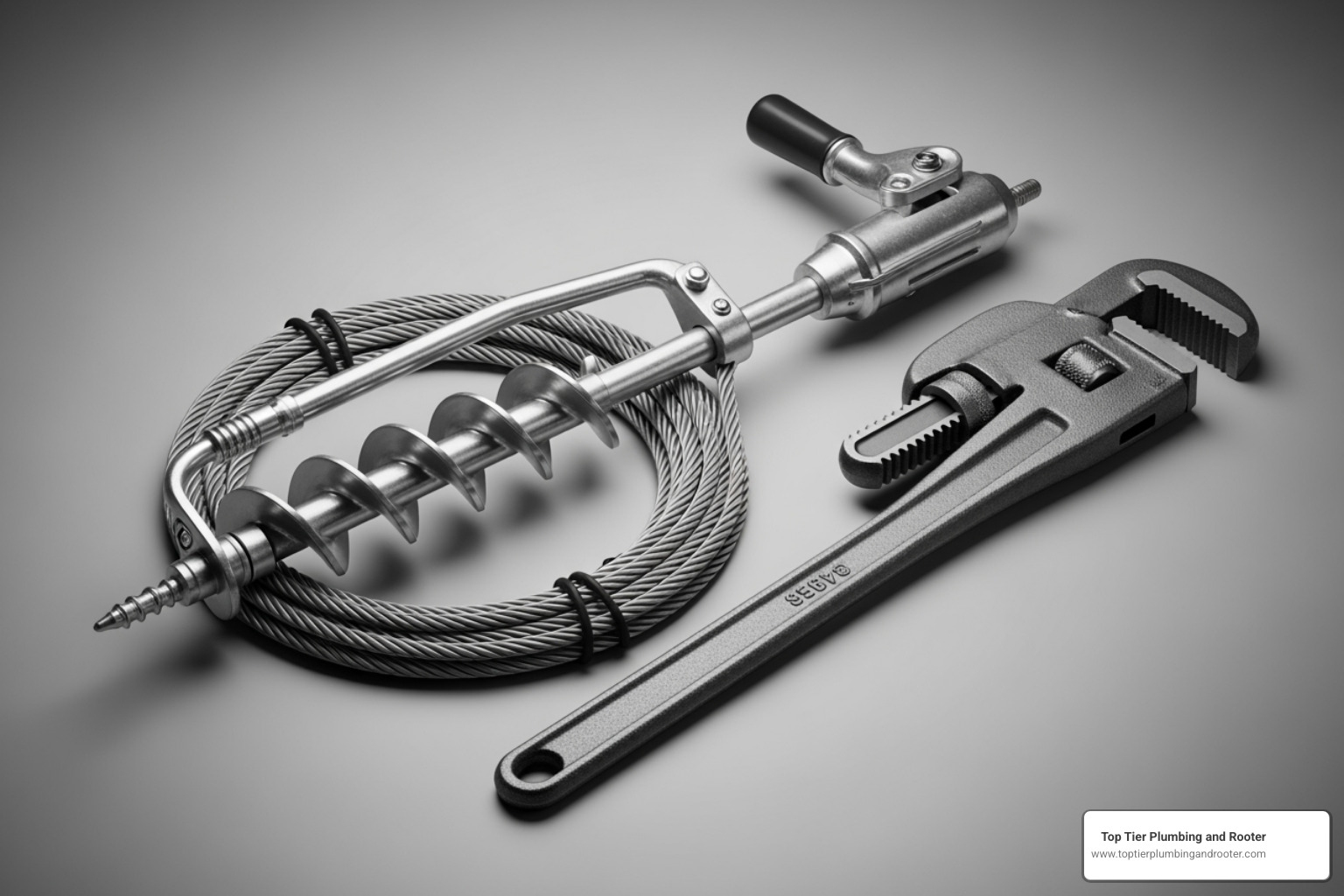
A pipe wrench is essential for loosening and tightening the cleanout cap. Make sure it’s the right size for your particular cleanout fitting.
Your most important tool is a plumbing snake or sewer auger. For main sewer line work, you’ll need a professional-grade model that’s typically 50 to 100 feet long. These aren’t cheap to buy, but most home improvement stores rent them for a reasonable daily rate. The auger has a long, flexible cable with a cutting head or corkscrew tip designed to break through or grab onto blockages.
Don’t forget your safety glasses, heavy-duty gloves, and buckets. A garden hose will be invaluable for flushing the line after you clear the clog and for cleaning your equipment when you’re done.
Step-by-Step: How to Perform a Sewer Line Unclog
Now comes the moment of truth. Take your time with each step – rushing will only create bigger problems.
Start by locating your main line cleanout. This is typically a white or black capped pipe about 3-4 inches wide, usually found near your home’s foundation, in the basement, or sometimes in a crawl space. If you see multiple cleanouts, choose the one closest to the street, as this accesses your main line.
When you loosen the cleanout cap with your pipe wrench, do it slowly. There’s likely built-up pressure behind that cap, and you don’t want a geyser of sewage hitting you in the face. Position your buckets and towels strategically around the area first.
Allow all the backed-up water and waste to drain out before proceeding. This can take several minutes, especially with a significant blockage. This step also relieves pressure in the system, making the rest of the process safer and more manageable.
Gently feed the auger cable into the drain pipe until you feel resistance – that’s your clog. Don’t force it, as you could damage your pipes. The key is patience and steady pressure.
Once you hit the blockage, it’s time to put that auger to work. Rotate the cable according to your tool’s instructions. Manual snakes require cranking a handle, while electric models have a motor. The rotating head will either break up the clog or snag it so you can pull it out. Here’s a pro tip: keep working the auger even after the main blockage feels cleared. This helps remove smaller debris pockets that could cause problems later.
Slowly retrieve the auger cable, using your garden hose to spray off debris as you pull it out. You’ll likely see some pretty gross stuff come out with it – that’s exactly what you want.
The final test is crucial for determining if your sewer line unclog was successful. After securely replacing the cleanout cap, run water from your garden hose down the cleanout and watch how it drains. Then head inside and test multiple fixtures – flush toilets, run sinks and showers. If everything flows freely, congratulations! You’ve successfully tackled a job that stumps many homeowners.
When to Put Down the Wrench: Signs You Need a Professional
Sometimes the best tool in your toolbox is knowing when to put it down. While we love empowering homeowners to tackle their own sewer line unclog projects, there are definitely times when calling in the pros isn’t just smart—it’s necessary.
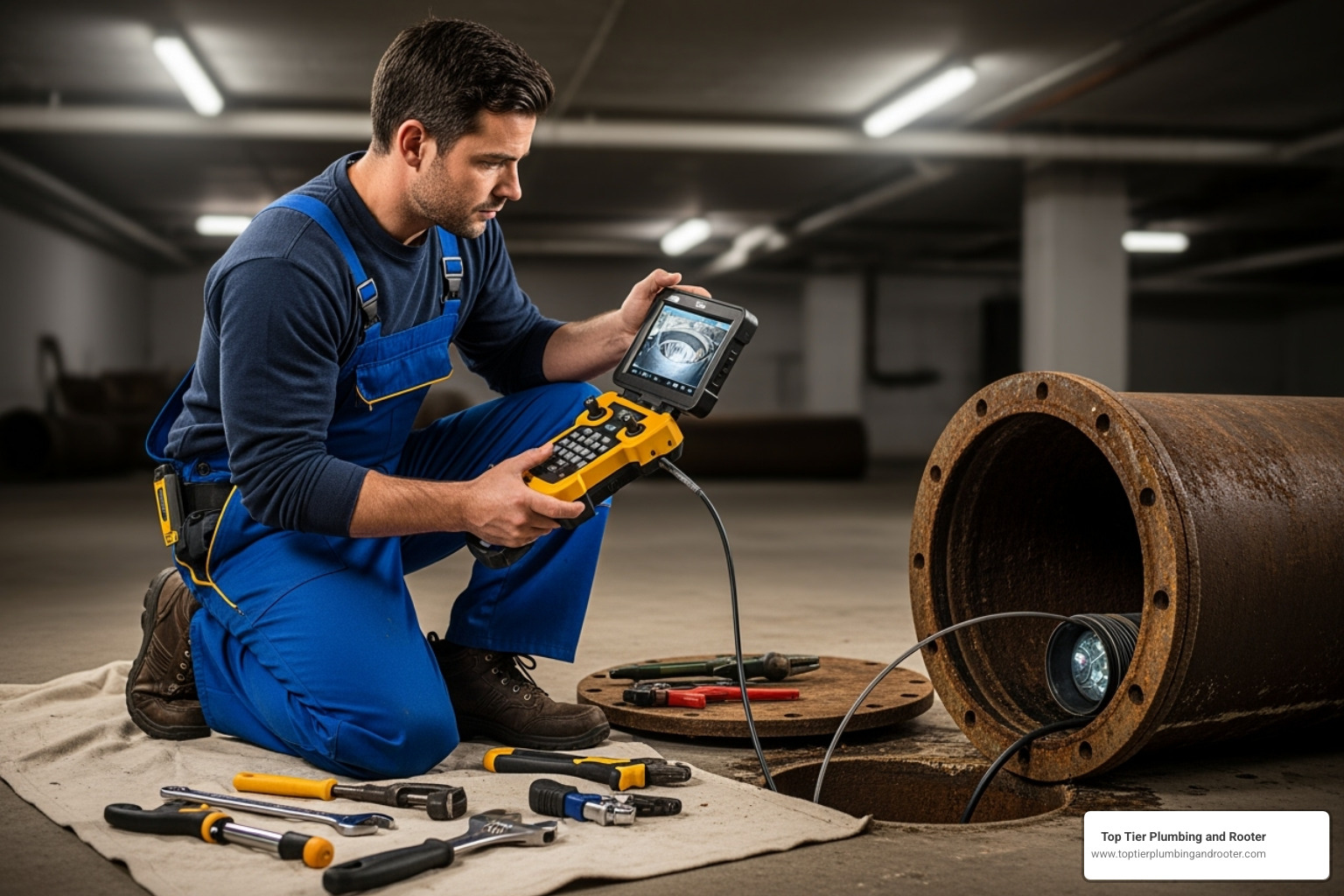
When your DIY methods fail, it’s time to wave the white flag. If you’ve spent hours working that auger and the clog is still laughing at your efforts, don’t keep banging your head against the wall. Professional plumbers have equipment that can reach deeper and work harder than anything you can rent from the hardware store.
Suspected tree root blockages are particularly stubborn enemies. Those sneaky roots don’t just create a simple clog—they create an underground jungle that grows back stronger each time you try to clear it. If you have mature trees near your sewer line and you’re dealing with recurring issues, you’re probably fighting roots. Professionals use specialized hydro-jetters that can slice through roots like a hot knife through butter and thoroughly clean your pipes.
Recurring clogs are like that friend who keeps showing up uninvited—they’re trying to tell you something. When the same sewer line unclog issue keeps coming back, it’s your plumbing system’s way of saying there’s a deeper problem. Maybe it’s a pipe belly where waste collects, or structural damage that needs more than a good snaking.
Watch for signs of damaged or collapsed pipes. If you notice soggy spots in your yard, sewage smells outside, or sudden dips in your lawn, your underground pipes might be crying for help. These issues go way beyond a simple clog and require professional assessment and repair.
Sewage backing up into your home or yard is an immediate red flag emergency. This isn’t just inconvenient—it’s a serious health hazard that needs professional intervention right now. Don’t try to be a hero when raw sewage is involved.
Professional plumbers bring game-changing technology to the table. They use video inspection cameras to actually see inside your pipes, taking all the guesswork out of the equation. It’s like having X-ray vision for your plumbing system. You can learn more about this fascinating technology in our article on The Role of Video Inspection in Sewer and Drain Repair.
For those urgent situations that can’t wait until morning, our guide on Sewer Clearing Emergency: How to Identify and Address Urgent Sewage Issues has you covered with essential information.
There’s no shame in calling for backup. Sometimes the smartest DIY move is knowing when to hand the job over to someone with the right tools and experience.
Keeping Drains Clear: How to Prevent Future Clogs
Let’s be honest – dealing with a sewer line unclog once is more than enough for most homeowners. The good news is that preventing future clogs is much easier (and less messy) than clearing them after they happen.
Proper waste disposal is your first line of defense against future headaches. Think of your drains as picky eaters and remember that your toilet isn’t a garbage can. To prevent clogs, never put the following items down your drains or toilet:
- Grease, oil, and fats: These harden in pipes and create sticky blockages. Let them cool and throw them in the trash.
- “Flushable” wipes: Despite the name, they don’t break down like toilet paper and are a primary cause of clogs.
- Other paper products: Paper towels, cotton swabs, and feminine hygiene products do not dissolve and will cause backups.
- Certain food waste: Coffee grounds, eggshells, fibrous foods (like celery), and starchy items (like pasta and rice) can create stubborn blockages, even with a garbage disposal.
Drain strainers are small investments that pay huge dividends. These simple mesh screens catch hair, food particles, and soap scum before they can start their journey toward your main sewer line. Clean them regularly, and you’ll be amazed at how much debris they catch.
For regular maintenance, try flushing your drains with very hot water weekly, especially after washing greasy dishes. A monthly treatment with baking soda and vinegar works wonders too – pour half a cup of baking soda down the drain, follow with half a cup of white vinegar, let it fizz for 15-30 minutes, then flush with hot water. It’s like a spa day for your pipes.
Mindful landscaping might seem unrelated to plumbing, but tree roots don’t care about property boundaries – they’ll happily invade your sewer lines if given the chance. When planting new trees or shrubs, research their root systems and keep them far from your sewer lines. If you already have mature trees, consider having a professional install root barriers.
Finally, annual professional inspections are like regular checkups for your plumbing system. Having a professional inspect your sewer line every one to three years helps catch small problems before they become expensive emergencies. This proactive approach is part of practicing good maintenance habits that keep your entire plumbing system running smoothly.
An ounce of prevention really is worth a pound of cure – especially when that cure involves dealing with raw sewage in your basement!
Your Local Sewer Line Experts in Riverside and San Bernardino
We hope this guide has given you the confidence to spot the warning signs of a main sewer line unclog issue and tackle basic blockages yourself. There’s real satisfaction in solving a plumbing problem with your own two hands – not to mention the money you’ll save when a simple snaking does the trick.
But here’s the thing we want you to remember: knowing when to stop is just as important as knowing when to start. If you’ve tried the DIY approach and that stubborn clog won’t budge, or if you’re hearing those telltale gurgling sounds that suggest tree roots have made themselves at home in your pipes, it’s time to call in the cavalry.
Attempting to force a solution when you’re dealing with damaged pipes or extensive root intrusion can turn a manageable problem into a costly nightmare. We’ve seen homeowners accidentally crack pipes or push debris further into the system, creating bigger headaches than they started with.
That’s where we come in. At Top Tier Plumbing and Rooter, we’ve been helping families throughout Riverside and San Bernardino counties get their plumbing back on track. Whether you’re dealing with a recurring sewer line unclog situation that keeps coming back like an unwelcome houseguest, or you’ve got multiple drains backing up and creating a genuine emergency, we’re here to help.
We understand that plumbing problems don’t follow a 9-to-5 schedule. That’s why we offer 24/7 availability for those middle-of-the-night disasters when sewage starts backing up into your home. We also provide same-day service and upfront pricing, so you’ll know exactly what you’re dealing with before we start any work.
Our commitment is simple: 100% customer satisfaction and quality work done right the first time. We bring professional-grade equipment, years of experience, and the kind of expertise that comes from tackling every type of sewer line challenge you can imagine.
Don’t let a persistent clog turn your home into a plumbing disaster zone. When DIY methods have reached their limits, Contact us for expert Sewer Cleaning services. We’re your neighbors, and we’re here to keep your drains flowing smoothly so you can get back to the things that really matter.


